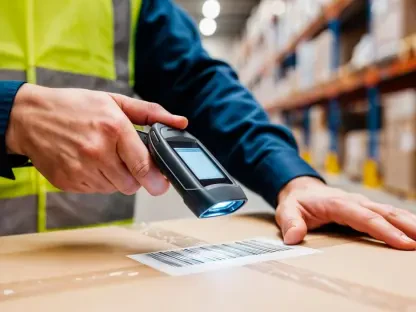In the fast-paced world of retail, payment systems have become the backbone of global commerce, processing trillions of dollars annually, and a staggering statistic reveals that digital payments alone accounted for over 50% of global transactions in recent years. This highlights a seismic shift toward technology-driven solutions, raising critical questions about how emerging innovations can further streamline efficiency, enhance security, and meet evolving consumer demands. As retailers and tech giants race to adapt, artificial intelligence (AI) and blockchain stand out as game-changing forces, poised to redefine how purchases are made and processed in an increasingly digital marketplace.
Overview of Retail Payment Systems in the Digital Age
Retail payment systems have undergone a profound evolution, transitioning from cash-based transactions to sophisticated digital platforms that power e-commerce and in-store purchases. Mobile wallets, contactless cards, and instant payment apps have become commonplace, driven by consumer demand for speed and convenience. These advancements reflect a broader trend of digitization, where technology underpins every aspect of the shopping experience, from discovery to checkout, shaping expectations for seamless interactions.
Major players in this space, including payment processors like Visa and Mastercard, alongside tech giants such as Apple and Google, dominate the landscape with innovative solutions. Their influence extends beyond mere transaction processing, as they integrate advanced analytics and user-friendly interfaces to enhance customer engagement. Meanwhile, the rise of fintech startups adds competitive pressure, pushing established firms to continuously innovate and adapt to market needs.
Amid this dynamic environment, AI and blockchain emerge as transformative forces with the potential to address longstanding challenges in security and efficiency. Their growing adoption signals a shift toward intelligent, decentralized systems that promise to bolster trust and reduce operational friction. For global commerce, the importance of secure and efficient payment mechanisms cannot be overstated, as they directly impact consumer confidence and retailer profitability in an interconnected economy.
The Impact of AI and Blockchain on Retail Payments
Emerging Trends and Technological Advancements
AI is reshaping retail payments by automating complex processes and delivering personalized experiences at scale. Through machine learning algorithms, systems can track consumer behavior, anticipate purchasing needs, and even initiate autonomous reordering for frequently bought items. This level of automation not only simplifies the shopping journey for customers but also enables retailers to optimize inventory and reduce errors in supply chain management.
Blockchain, on the other hand, introduces a new paradigm of security and transparency with decentralized payment networks. By recording transactions on immutable ledgers, it minimizes the risk of fraud and ensures that every exchange is verifiable. Smart contracts further enhance this by automating payment releases upon fulfillment of predefined conditions, cutting down delays and eliminating intermediaries in the process.
Consumer expectations are evolving in tandem with these technologies, demanding faster transactions and tailored services. Retailers leveraging AI and blockchain can meet these needs by streamlining operations and offering real-time insights into purchasing patterns. This synergy creates opportunities to build loyalty through customized promotions and efficient checkout experiences, positioning businesses to thrive in a competitive digital landscape.
Market Growth and Future Projections
The adoption of AI and blockchain in retail payments is accelerating, with significant growth metrics underscoring their impact. Recent data indicates that over 30% of large retailers have already integrated AI tools for payment processing and customer analytics, while blockchain-based payment systems are gaining traction, especially in cross-border transactions. Market forecasts project that the digital payments sector will expand at a compound annual growth rate of 15% from now until 2027, driven largely by these innovations.
Performance indicators further highlight the benefits, with AI reducing transaction processing times by up to 40% in some implementations, while blockchain cuts costs associated with fraud and intermediaries by substantial margins. These efficiencies translate into tangible gains for businesses, allowing smaller retailers to compete with larger counterparts through accessible, scalable solutions. The numbers paint a clear picture of technologies that are not just supplementary but foundational to future growth.
Looking ahead, expert predictions suggest that AI and blockchain will dominate retail payment systems within the next decade. Industry analysts anticipate a near-universal shift to intelligent, decentralized platforms as interoperability improves and costs decline. This trajectory points to a marketplace where rapid, data-driven decisions and secure transactions become the norm, fundamentally altering the economics of retail operations.
Challenges in Adopting AI and Blockchain for Retail Payments
Implementing AI and blockchain in retail payments is not without obstacles, as technological limitations pose significant hurdles. Blockchain networks, for instance, often struggle with scalability, processing fewer transactions per second compared to traditional systems, which can hinder widespread adoption. Similarly, AI algorithms may exhibit biases if trained on incomplete data, potentially leading to unfair pricing or customer profiling issues that erode trust.
Regulatory uncertainties compound these challenges, particularly around data privacy and cryptocurrency transactions tied to blockchain. Laws governing personal information, such as GDPR in Europe and CCPA in California, impose strict requirements on AI usage, while evolving standards for digital currencies create compliance complexities. Retailers must navigate this fragmented landscape, balancing innovation with legal obligations, often at considerable expense.
Market barriers also play a role, with high initial costs deterring small and medium-sized businesses from adopting these technologies. However, potential solutions are emerging, including public-private partnerships that subsidize implementation and advancements in interoperable systems that reduce integration friction. Addressing these challenges requires collaborative efforts across industries to ensure that the benefits of AI and blockchain are accessible to all players in the retail ecosystem.
Regulatory Landscape for AI and Blockchain in Retail Payments
The regulatory framework governing AI and blockchain in retail payments is intricate, reflecting the technologies’ disruptive nature. Data protection laws set stringent guidelines for AI applications, mandating transparency in how consumer information is collected and processed. Non-compliance can result in hefty fines and reputational damage, underscoring the need for robust governance structures within organizations deploying these tools.
Blockchain faces its own set of regulatory considerations, particularly in the realm of cryptocurrency transactions often associated with decentralized payments. Anti-money laundering rules and taxation policies are still taking shape in many jurisdictions, creating ambiguity for businesses using blockchain for settlements. Harmonized international standards remain a distant goal, though efforts are underway to align policies that foster innovation without compromising security.
Compliance is not merely a legal obligation but a cornerstone of consumer trust and transaction security. Retailers adhering to regulations can differentiate themselves by demonstrating commitment to ethical practices, which in turn shapes industry norms. As regulators and stakeholders collaborate, the potential for streamlined frameworks that support technological advancement grows, paving the way for safer, more reliable payment systems.
The Future of Retail Payments with AI and Blockchain
The long-term outlook for retail payments envisions a landscape transformed by cutting-edge applications of AI and blockchain. Innovations such as AI-powered dynamic pricing, which adjusts costs based on real-time demand and consumer behavior, promise to maximize retailer margins while offering value to shoppers. Simultaneously, blockchain-enabled cross-border payments could eliminate traditional banking delays, facilitating instant global transactions at reduced fees.
Emerging disruptors like decentralized finance (DeFi) are also set to challenge conventional payment models by offering peer-to-peer solutions independent of centralized institutions. Shifting consumer preferences toward transparency and immediacy will further drive adoption of these technologies, as trust becomes a key differentiator in crowded markets. Retailers must stay attuned to these changes to remain relevant amid rapid industry shifts.
Several factors will influence this future, including global economic trends that dictate investment in tech infrastructure and breakthroughs that lower entry barriers. Regulatory evolution will also play a pivotal role, potentially accelerating deployment if supportive policies are enacted. Together, these elements suggest a retail payment ecosystem where speed, intelligence, and security converge to redefine transactional norms on a global scale.
A New Era for Retail Payments
Reflecting on the insights gathered, it becomes evident that AI and blockchain have laid the groundwork for a transformative shift in retail payments, automating processes and securing transactions with unprecedented precision. The journey through their impact revealed a dual advantage, where retailers gain from cost efficiencies and operational improvements, while consumers enjoy enhanced convenience and transparency. This synergy marks a turning point in how commerce is conducted.
Moving forward, stakeholders are encouraged to prioritize early adoption, leveraging scalable solutions and partnerships to overcome initial barriers. Investing in interoperable systems and staying abreast of regulatory developments emerges as critical steps to ensure sustainable integration. These actionable strategies promise to position businesses at the forefront of innovation, ready to capitalize on the next wave of technological advancements.
Beyond immediate actions, a broader consideration surfaces around fostering collaboration across sectors to address scalability and compliance challenges. Establishing industry-wide standards and sharing best practices could accelerate the transition to intelligent, decentralized payment systems. This collective approach holds the potential to unlock a future where retail transactions are not only seamless but also inherently trustworthy, setting a new benchmark for global trade.









